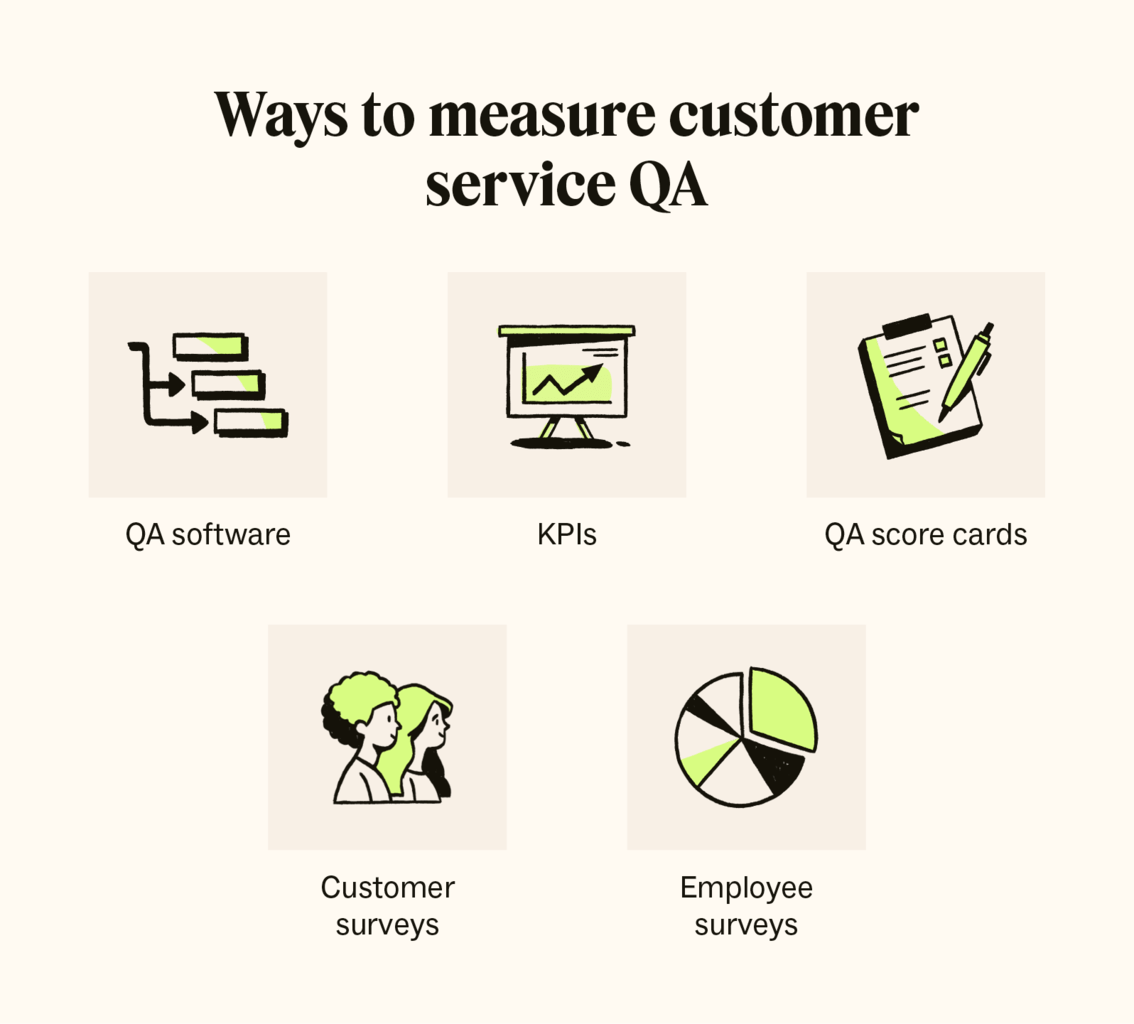Article • 1 min read
Customer service quality assurance: The ultimate guide
Customer service quality assurance can help you provide a better customer experience. Learn all about the QA process in our guide.
Por Hannah Wren, Staff Writer
Última atualização em August 19, 2024
What is customer service quality assurance?
Customer service quality assurance (QA) is a systematic process of evaluating customer interactions, identifying areas for improvement, and providing effective coaching to enhance the overall customer experience.
Restaurants don’t attain Michelin-star status by chance. From setting the menu to plating, a chef is monitoring the quality and progression of the dish from start to finish. And at the end of the line, the head chef makes a final check before sending the meal to the table. All of this is to promote consistent experiences for the customer—and you can apply this same method to your business.
Customer service quality assurance is a strategy that evaluates customer support interactions and identifies where you can improve to provide five-star service. In this guide, we touch on why QA is so important, how you can establish it in your organization, and how it relates to the customer experience (CX).
More in this guide:
- Why is quality assurance an important part of customer support?
- Benefits of customer service QA
- How do you measure quality assurance in customer service?
- 6 steps to establish customer service quality assurance in your organization
- Frequently asked questions
- Achieve your customer service QA goals with Zendesk
Why is quality assurance an important part of customer support?
QA is important to customer support because organizations can use it to ensure their support teams provide consistent, high-quality service that exceeds customer expectations.
Customers want outstanding experiences whenever they connect with your business—and the right QA processes can help you deliver. According to the Zendesk QA Customer Service Quality Benchmark Report 2023:
86% of surveyed organizations agree QA processes like conversation reviews improve the quality of customer service.
- 76% of surveyed organizations agree that QA helps to improve customer satisfaction (CSAT).
You can use quality assurance to improve the CX, create personalized interactions, and turn simple customer transactions into relationships.
Benefits of customer service QA

Customer service QA provides a wealth of benefits that can impact nearly every aspect of your organization, whether you’re in a call center, a contact center, or on a remote support team. Here are some of the most impactful advantages of quality assurance.
Identifies areas of improvement
Arguably the most important benefit of quality assurance is identifying areas of improvement. With an effective QA process, you can highlight your team’s performance trends, identify root causes of inefficiencies, and implement corrective processes. You can also use quality assurance alongside your customer service key performance indicators (KPIs) to facilitate more impactful data-driven decision-making.
Enhances the customer experience
Quality assurance can help you evaluate the state of your support interactions. By consistently monitoring these interactions, you can identify pain points, inefficiencies, and roadblocks in the customer experience.
For example, maybe your agents are unknowingly ending conversations incorrectly—perhaps they’re not asking if there’s anything else they can do for the customer. You can provide a better CX and deliver good customer service by identifying and correcting these sub-optimal interactions.
Boosts agent performance
During QA, managers or other team leaders cananalyze agent performance, identifying agent strengths and areas for improvement. Managers can use this information to provide constructive feedback and reviews as well as tailor training programs designed to improve your support team’s customer service skills.
Improves the employee experience
An efficient quality assurance process can directly contribute to the employee experience (EX). You can use QA to speed up new hire onboarding, provide ongoing coaching and training, and facilitate career growth. Doing so shows your team that you are invested in their development, which can result in improved job satisfaction and lower employee turnover.
Drives customer loyalty
Customer loyalty, or how likely consumers are to make repeat purchases with your company, is directly linked to the customer experience. Quality assurance can help you understand what’s lacking in your CX, identify and rectify problematic agent activities, and build an effective support system. This can boost customer retention, reduce churn rate, and build long-term customer relationships.
How do you measure quality assurance in customer service?

Depending on your organizational structure and business needs, you can measure quality assurance in customer service a few different ways, including with:
- QA software: Quality assurance software uses AI to improve the customer experience. It can automate important tasks, highlight problematic agent conversations, highlight areas for improvement, and more.
- KPIs: Identify and monitor important KPIs, like first contact resolution, to evaluate how effective your support interactions are and how well process changes were implemented.
- QA score cards: QA score cards grade support agents on their introduction, customer service voice, and customer resolutions. You can use score cards for voice calls, email support, messaging, and any other form of customer service communication.
- Customer surveys: When in doubt, ask your customers directly. Request customer feedback through a method like Net Promoter Score® (NPS) for better insight on how customers gauge your support.
- Employee surveys: It’s also important to understand what your customer service team is thinking. Conduct employee satisfaction surveys to identify how they feel about their role and their perspective on your support strategy.
You don’t need to implement every method included above, but combining a few of them is a good idea to get a well-rounded view of your QA efforts.
6 steps to establish customer service quality assurance in your organization

Now that we’ve covered how important customer support quality assurance is, we’ll dive into some ways you can bring it to your organization. Here are six steps to follow.
1. Define your support vision and goals
Before making any progress in your QA process, you’ll want to clearly define what “quality” means to your team. Take time to assess your current operations. Identify your ideal support vision, what’s important to your customers, and your future goals.
Some organizations may take a cost-focused approach and want to improve agent efficiency to lower labor costs. Others may take a customer-focused approach and want to prioritize improving a related metric like Customer Effort Score (CES).
Whatever your focus is, you’ll create a more effective strategy by aligning your support vision and goals.
2. Pick rating categories for your QA score cards
When developing your QA score cards, it’s important to select the rating categories that align with your vision and goals. For example, if you want to emphasize the beginning of the support conversation, you might choose grading categories for that part of the interaction. This can include the first introduction, using the customer’s name immediately, identifying the customer’s issue, and how empathetic the agent sounds.
3. Choose which conversations to review
Any size business can experience hundreds of customer interactions per week, but it’s inefficient to review every single one. Instead, choose the most important variables to focus on and prioritize conversations with those attributes. QA software with AI and automation features can help with this.
For example, if product knowledge, identification of customer needs, and solution effectiveness are most important for you, AI can automatically scan all conversations for these variables and highlight problematic interactions. This empowers managers to review the right conversations and identify bad customer service without wasting time sifting through everything.
4. Plan calibration sessions
It’s likely that multiple individuals will complete QA reviews of your support agents. Therefore, businesses need to ensure that every quality reviewer follows the same criteria and rating system—and that’s where calibration sessions come in.
Calibration sessions are guidelines for reviewers, promoting consistency and ensuring every manager grades support agents on the same criteria. During these sessions, revisit your QA score card categories, rating scale, general approach, and more to ensure balanced reviews.
5. Measure customer service quality
Once you have a QA system in place, consistently measure customer service quality to ensure your process is effective. Monitor your KPIs like CSAT and customer survey results, noting your performance, and review support conversations and QA score cards to see if you’re trending up or down. By regularly measuring your service quality, you can identify areas of improvement in your process and optimize your customer service training.
6. Close the feedback loop
Data can only tell you so much—it’s what you do with that data that separates good QA from great QA. Use customer feedback or your QA score card data to implement targeted coaching sessions and training to improve your processes and team. When you close the feedback loop and support your employees with additional training, you can improve your QA processes.
Frequently asked questions
Achieve your customer service QA goals with Zendesk
Customer service quality assurance can turn your organization from an inefficient operation to a five-star establishment. That said, you need the right tools and methods to measure QA and monitor it daily. That’s where we can help.
Zendesk provides AI-powered customer service quality management tools. With Zendesk QA, Zendesk customers can implement high-quality CX and QA strategies that drive customer loyalty and improve agent retention.
Try it for free today.
Net Promoter, Net Promoter Score, and NPS are registered trademarks of Satmetrix Systems, Inc., Bain & Company, Inc., and Fred Reichheld.
